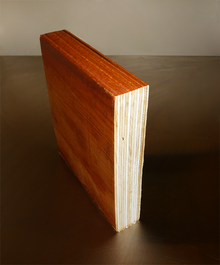- Laminated veneer lumber
-
Laminated veneer lumber (LVL) is an engineered wood product that uses multiple layers of thin wood assembled with adhesives. It offers several advantages over typical milled lumber: it is stronger, straighter, and more uniform. It is much less likely than conventional lumber to warp, twist, bow, or shrink due to its composite nature. Made in a factory under controlled specifications, LVL products allow users to reduce the onsite labor. They are typically used for headers, beams, rimboard, and edge-forming material.
It is similar in appearance to plywood without crossbands,[1] and is typically rated by the manufacturer for elastic modulus and allowable bending stress. Common elastic moduli are 1,800,000 psi (12,000 MPa); 1,900,000 psi (13,000 MPa); and 2,000,000 psi (14,000 MPa); and common allowable bending stress values are 2,800 psi (19 MPa); and 3,000 psi (21 MPa).
A comparable material is parallel strand lumber (PSL), which is used in the same applications. Rather than being manufactured from full, parallel veneers, Parallel Strand uses veneers with more defects in a more random-looking pattern. Laminated strand lumber (LSL) is another similar type that uses smaller veneers, and so is similar to oriented strand board (OSB) in appearance.[2] Laminated Veneer, Parallel Strand, and Laminated Strand all belong to the general category of Structural Composite Lumber.
- ^ Allen, Edward and Joseph Iano. Fundamentals of Building Construction: Fourth Edition. Hoboken: John Wiley & Sons, 2004. pg. 91
- ^ http://www3.telus.net/selkirk99/selkirk/Beams/beams.html
Categories:- Plywood
- Engineered wood
- Composite materials
- Woodworking stubs
Wikimedia Foundation. 2010.

